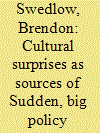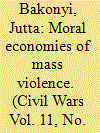|
|
|
Sort Order |
|
|
|
Items / Page
|
|
|
|
|
|
|
| Srl | Item |
| 1 |
ID:
110654


|
|
|
|
|
| Publication |
2011.
|
| Summary/Abstract |
A major complaint against cultural theories is that they cannot explain political change (Lockhart 1997). Cultural and institutional accounts of politics are also often seen as antagonistic (Chai 1997; Grendstad and Selle 1995; Lockhart 1999). The cultural theory (CT) developed by Mary Douglas, Aaron Wildavsky, and others (see, e.g., Schwarz and Thompson 1990; Thompson, Ellis, and Wildavsky 1990), by contrast, offers a theory of culture that includes a theory of cultural change that integrates institutions into its explanation of change (Lockhart 1997, 1999; Thompson, Ellis, and Wildavsky 1990, 69-81; Wildavsky 1985). Moreover, CT can help specify the cultural conditions for sudden, big institutional and policy change, thereby, I argue, strengthening Frank Baumgartner and Bryan Jones's "punctuated equilibria" (PE) theory of change (Baumgartner and Jones 1993, 2002). The plausibility of this CT of PE change is illustrated in this article by using it to explain dramatic changes in forest and wildlife management in the Pacific Northwest (PNW) (building on Swedlow 2002a, b, 2003, 2007, 2009, and 2011a, b).
|
|
|
|
|
|
|
|
|
|
|
|
|
|
|
|
| 2 |
ID:
103126


|
|
|
|
|
| Publication |
2009.
|
| Summary/Abstract |
The focus in the article is on the beginning and expansion of the Somali war between 1988 and 1992. Three patterns and dynamics of mass-mobilisation are comparatively examined: the relatively sudden transformation of the northern guerrilla struggle in a civil war 1988, the expansion of the war to the southern region after 1989 and the mass-upheaval in Mogadishu 1990/91. Although clan-affiliation became a prominent tool to mobilising violence and to framing friends and foes throughout Somalia, the patterns of organising clan-relations within the insurgent movements and between the movements and the non-armed population differed and laid the basis for the different trajectories of violence in the Somali regions.
|
|
|
|
|
|
|
|
|
|
|
|
|
|
|
|
|
|
|
|
|